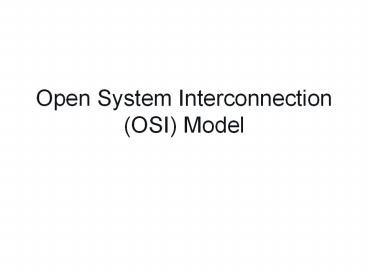Open System Interconnection (OSI) Model - PowerPoint PPT Presentation
Title:
Open System Interconnection (OSI) Model
Description:
Provides file transfer services. Provides file management services. Provides terminal emulation services. Communicating Between Stacks ... – PowerPoint PPT presentation
Number of Views:214
Avg rating:3.0/5.0
Title: Open System Interconnection (OSI) Model
1
Open System Interconnection (OSI) Model
2
Objectives
- Explain the OSI reference model, which sets
standards for LAN and WAN communications - Discuss communication between OSI stacks when two
computers are linked through a network - Apply the OSI model to realistic networking
situations
3
OSI Reference Model
- Foundation that brings continuity to LAN and WAN
communications - Product of two standards organizations
- ISO
- ANSI
- Developed in 1974
- Set of communication guidelines for hardware and
software design
4
OSI Guidelines Specify
- How network devices contact each other how
devices using different protocols communicate - How a network device knows when to transmit and
not transmit data - How physical network network devices are arranged
and connected
5
OSI Guidelines Specify
- Methods to ensure that network transmissions are
received correctly - How network devices maintain a consistent rate of
data flow - How electronic data is represented on network
media
6
OSI Layers
7
OSI Layers
- Bottom layers
- Support for physical connectivity, frame
formation, encoding, and signal transmission - Middle layers
- Establish and maintain a communication session
between two network nodes - Monitor for error conditions
- Uppermost layers
- Application/software support for encrypting data
and assuring interpretation/presentation of data
8
Physical Layer Functions
- Provides transfer medium (eg, cable)
- Translates data into a transmission signal
- Sends signal along the transfer medium
- Includes physical layout of network
- Monitors for transmission errors
- Determines voltage levels for data signal
transmissions and to synchronize transmissions - Determines signal type (eg, digital or analog)
9
Analog Signals
10
Digital Signals
11
Data Link Layer Functions
- Constructs data frames
- Creates CRC information checks for errors
- Retransmits data if there is an error
- Initiates communications link makes sure it is
not interrupted (ensures node-to-node physical
reliability) - Examines device addresses
- Acknowledges receipt of a frame
12
Data Link Layer
- Data link frame contains fields consisting of
address and control information - Two important sublayers
- Logical link control (LLC)
- Media access control (MAC)
- Connectionless service versus connection-oriented
service
13
Network Layer Functions
- Determines network path for routing packets
- Helps reduce network congestion
- Establishes virtual circuits
- Routes packets to other networks, resequencing
packet transmissions when needed - Translates between protocols
14
Transport Layer Functions
- Ensures reliability of packet transmissions
- Ensures data is sent and received in the same
order - Sends acknowledgement when packet is received
- Monitors for packet transmission errors and
resends bad packets - Breaks large data units into smaller ones and
reconstructs them at the receiving end for
networks using different protocols
15
Session Layer Functions
- Establishes and maintains communications link
- Determines which node transmits at any point in
time - Disconnects when communication session is over
- Translates node addresses
16
Presentation Layer Functions
- Translates data to a format the receiving node
understands (eg, from EBCDIC to ASCII) - Performs data encryption
- Performs data compression
17
Application Layer Functions
- Enables sharing remote drivers and printers
- Handles e-mail messages
- Provides file transfer services
- Provides file management services
- Provides terminal emulation services
18
Communicating Between Stacks
- OSI model provides standards for
- Communicating on a LAN
- Communicating between LANs
- Internetworking between LANs and WANs and between
WANs and WANs
19
20
Peer Protocols
21
Applying the OSI Model































